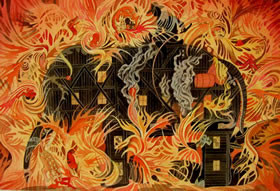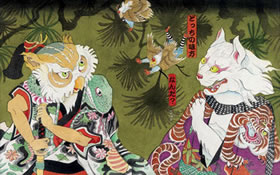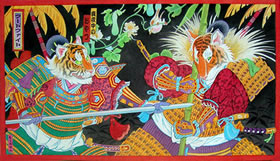Press / ArtScene
MOIRA HAHN
 January 10 - February 28, 2009 at Koplin Del Rio Gallery, Culver City January 10 - February 28, 2009 at Koplin Del Rio Gallery, Culver City
by Suvan Geer
Stories within stories play out inside Moira Hahn’s colorful watercolor paintings. Hahn is a clever visual storyteller with a wry sense of humor. She spins layered tales of excess and caution in vivid images seemingly ripped from ancient Asian scrolls and Japanese woodblock prints. In some of her images tigers fight to the death dressed as noble samurai; cartoonish cats wearing fierce kimonos are bedeviled by small, bird-like creatures; a moody crane in a floral-stained robe gathers morning glories beneath a dark violet cloud. Like any good story or fable however, within Hahn’s images we sense that, while we are being beguiled by the comic book vibrancy of her anthropomorphic animals, there is something deeper to be found.
Her newest series, entitled “Night Vision,” spins tales related to the artist’s concerns over climate change, endangered species and other global effects on the environment of human actions. As she has in the past, she sites many of these narratives of survival, struggle and unexpected comeuppance in the motifs and populist spirit of 18th- and 19th-century Japanese ukiyo-e prints. It’s a gambit indebted as much to her childhood enthusiasm for her family’s collection of Chinese and Japanese art as her own intense study of Asian art, not to mention years spent assisting Masami Teraoka.
 By appropriating the historic ukiyo-e, or “pictures of the floating world,” originally created to appeal to Japan’s nouveau riche merchant class of the Edo period, artists like Teraoka and Hahn deftly suggest there are strong parallels between the expansive, culture-altering world trade of that age and our own global economy. Hahn’s presentation of this new/old world is a densely patterned, free floating conglomeration of influences marked by exquisite style, rich color, and visual stimulation. In it she makes nodding references to an eclectic mix of cultural myths, items from the news, advertising, anime and even her own garden. In this conflated realm of the real and the symbolic, the ancient and the new, her animals are the staged players of mysterious, always thoughtful and frequently irreverent narratives. By appropriating the historic ukiyo-e, or “pictures of the floating world,” originally created to appeal to Japan’s nouveau riche merchant class of the Edo period, artists like Teraoka and Hahn deftly suggest there are strong parallels between the expansive, culture-altering world trade of that age and our own global economy. Hahn’s presentation of this new/old world is a densely patterned, free floating conglomeration of influences marked by exquisite style, rich color, and visual stimulation. In it she makes nodding references to an eclectic mix of cultural myths, items from the news, advertising, anime and even her own garden. In this conflated realm of the real and the symbolic, the ancient and the new, her animals are the staged players of mysterious, always thoughtful and frequently irreverent narratives.
That comes through clearly in the triptych “Thanatopsis.” Two traditionally garbed cats act out a melodramatic Kabuki play about ritual suicide. Almost hidden within their elaborate costumes and the stylized patterns in the panels are the laughing Bunraku bird puppeteers who animate the hapless cats’ drama. The birds’ tittering delight in enabling the dramatic demise of their old enemy is spelled out in the work’s cartouche, and translated on the wall text next to the image. By imaging this narrative in terms of ancient, interspecies rivalry Hahn playfully brings to mind all manner of covert operations and political agendas.
 “Next Exit” is a visual explosion with a stylized flaming elephant. A vivid take on symbolic Buddhist Tibetan tanka painting, Hahn’s animated flames spiral and whirl, alive with mythical beasts and angry spirits. Our reading of the meaning of the flaming beast is as shifting as the flames. We note that the “elephant” is a wooden construction, with windows and orange barrels falling from one flank. Thoughts cascade around, suggesting everything from a Burning Man entertainment spectacle, to a Trojan horse, to an arsonist ignited warehouse. Then amidst the spiraling flames we notice the dark silhouetted figure of a man calmly digging for something on the beast’s back. His Texan hat and boots and the freeway-centric title lead us then to muse on automobile-wrought destruction, and the kinds of actions that fuel our blazing love of energy consumption and excess in general. “Next Exit” is a visual explosion with a stylized flaming elephant. A vivid take on symbolic Buddhist Tibetan tanka painting, Hahn’s animated flames spiral and whirl, alive with mythical beasts and angry spirits. Our reading of the meaning of the flaming beast is as shifting as the flames. We note that the “elephant” is a wooden construction, with windows and orange barrels falling from one flank. Thoughts cascade around, suggesting everything from a Burning Man entertainment spectacle, to a Trojan horse, to an arsonist ignited warehouse. Then amidst the spiraling flames we notice the dark silhouetted figure of a man calmly digging for something on the beast’s back. His Texan hat and boots and the freeway-centric title lead us then to muse on automobile-wrought destruction, and the kinds of actions that fuel our blazing love of energy consumption and excess in general.
For all Hahn’s political commentary, however, it is her work’s imagination and the fascinating way she uses color, line and pattern in her images that make them so absorbing. Her fabric patterns are delightful and lush. They fracture bodies into dynamic forms that pile up in interesting visual ways. Her landscapes break up surrounding space into carefully balanced areas of positive and negative shape that entices the eye to move around the scene. If the life of a story is in the details, Hahn’s skill makes us dwell on those details. We may not always be sure if we are seeing parable or parody, symbol or narrative. But the work’s beauty and its intriguing ambiguity grab and hold our interest.
|

